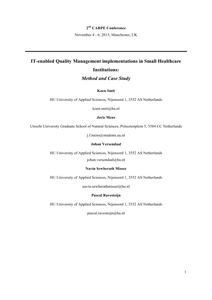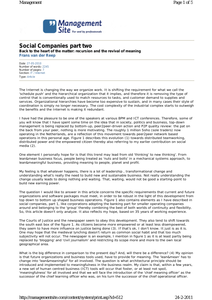Enterprise Resource Planning (ERP) refers to a specific type of software used by companies to manage day-to-day business activities, including but not limited to accounting, procurement, project management, compliance and risk management, and supply chain operations. This chapter presents a literature review on the different perspectives and applications of ERP systems in the industrial sector in the last 20 years. As a result, most of the documented cases are related to the implementation of System Application and Product (SAP) and its different modules. A case study of the performance of CONTPAQi software in a small and medium-sized enterprise (SME) that relies on the ABC tool for inventory control is included.
DOCUMENT
In recent years business process management (BPM) and specifically information systems that support the analysis, design and execution of processes (also called business process management systems (BPMS)) are getting more attention. This has lead to an increase in research on BPM and BPMS. However the research on BPMS is mostly focused on the architecture of the system and how to implement such systems. How to select a BPM system that fits the strategy and goals of a specific organization is largely ignored. In this paper we present a BPMS selection method, which is based on research into the criteria that are important for organizations, which are going to implement a BPMS.
DOCUMENT

Unlike common nouns, person names refer to unique entities and generally have a referring function. We used event-related potentials to investigate the time course of identifying the emotional meaning of nouns and names. The emotional valence of names and nouns were manipulated separately. The results show early N1 effects in response to emotional valence only for nouns. This might reflect automatic attention directed towards emotional stimuli. The absence of such an effect for names supports the notion that the emotional meaning carried by names is accessed after word recognition and person identification. In addition, both names with negative valence and emotional nouns elicited late positive effects, which have been associated with evaluation of emotional significance. This positive effect started earlier for nouns than for names, but with similar durations. Our results suggest that distinct neural systems are involved in the retrieval of names' and nouns' emotional meaning.
LINK
Both emotional words and words focused by information structure can capture attention. This study examined the interplay between emotional salience and information structure in modulating attentional resources in the service of integrating emotional words into sentence context. Event-related potentials (ERPs) to affectively negative, neutral, and positive words, which were either focused or nonfocused in question-answer pairs, were evaluated during sentence comprehension. The results revealed an early negative effect (90-200 ms), a P2 effect, as well as an effect in the N400 time window, for both emotional salience and information structure. Moreover, an interaction between emotional salience and information structure occurred within the N400 time window over right posterior electrodes, showing that information structure influences the semantic integration only for neutral words, but not for emotional words. This might reflect the fact that the linguistic salience of emotional words can override the effect of information structure on the integration of words into context. The interaction provides evidence for attention-emotion interactions at a later stage of processing. In addition, the absence of interaction in the early time window suggests that the processing of emotional information is highly automatic and independent of context. The results suggest independent attention capture systems of emotional salience and information structure at the early stage but an interaction between them at a later stage, during the semantic integration of words.
LINK
Doelstellingen Na bestudering van dit hoofdstuk: • weet je dat gereguleerde marktwerking in het Nederlandse zorgstelsel niet zonder problemen is; • weet je dat bekostiging van zorg in belangrijke mate bepalend is voor de inrichting en vormgeving van zorgprocessen; • besef je dat de huidige regels rondom bekostiging van zorg de inrichting van preventieve zorg in de weg staan; • heb je kennis genomen van alternatieve vormen van bekostiging van zorg, ieder met eigen voordelen en nadelen; • besef je dat een zorgdomeinoverstijgend perspectief noodzakelijk is, omdat een goede gezondheid ook bepaald wordt door factoren die buiten het zorgdomein liggen; • weet je dat maatschappelijke effecten niet altijd in cijfers zijn uit te drukken en dat een maatschappelijke kosten-batenanalyse hier mogelijk uitkomst kan bieden; • heb je kennis genomen van het ‘waarom’, ‘hoe’ en ‘wat’ van businessmodellen in de zorg.
DOCUMENT

Kwaliteitsmanagement is lange tijd gekenmerkt geweest door wat je het empirisch paradigma (Van Kemenade & Hardjono, 2018) zou kunnen noemen. Binnen die manier van denken is kwaliteitskunde meten en gaat het onder andere om prestatie-indicatoren. Kwaliteit is voldoen aan de vereisten. Verbetering en verandering is te plannen. Statistiek is zijn belangrijkste wetenschap. De manager controleert. Een risico echter van dit kwaliteitsparadigma is, dat er een enorme bureaucratie ontstaat. Erger nog: ze houdt onvoldoende rekening met de complexiteit van het huidige tijdsgewricht.
DOCUMENT

Aesthetic experiences have an influence on many aspects of life. Interest in the neural basis of aesthetic experiences has grown rapidly in the past decade, and fMRI studies have identified several brain systems supporting aesthetic experiences. Work on the rapid neuronal dynamics of aesthetic experience, however, is relatively scarce. This study adds to this field by investigating the experience of being aesthetically moved by means of ERP and time–frequency analysis. Participants' EEG was recorded while they viewed a diverse set of artworks and evaluated the extent to which these artworks moved them. Results show that being aesthetically moved is associated with a sustained increase in gamma activity over centroparietal regions. In addition, alpha power over right frontocentral regions was reduced in high- and low-moving images, compared to artworks given intermediate ratings. We interpret the gamma effect as an indication for sustained savoring processes for aesthetically moving artworks compared to aesthetically less-moving artworks. The alpha effect is interpreted as an indication of increased attention for aesthetically salient images. In contrast to previous works, we observed no significant effects in any of the established ERP components, but we did observe effects at latencies longer than 1 sec. We conclude that EEG time–frequency analysis provides useful information on the neuronal dynamics of aesthetic experience.
DOCUMENT
In the dynamic environment of increasing regulations, increasing patient demand, decentralization of budgets and enforcement of efficiency, small sized healthcare institutions in the Netherlands are having a difficult time. Although these service providers are usually capable of flexibly delivering healthcare, the investment and overhead for implementing and executing on required quality management standards like ISO 9001 is difficult. In this paper we construct a method for the implementation of an IT-enabled quality management system for small sized healthcare institutions, which is applied through case study. The case organisation provides intra- and extramural care for mentally handicapped persons and young adults with a psychiatric disorder. The quality management system implementation is based on 1) a lightweight IT infrastructure (based at a secure data centre and accessible through remote login) implying secure storage of patients' medical and personal information. Furthermore, the Deming (Deming, 1982) cycle enabled processes and protocols are 2) described in an e-handbook and prototyped via an open source process management system which supports the quality regulation demanded for providing care to patients. The case study supports the validity of our method and the fact that small sized healthcare institutions are able to execute their care while adhering to ISO 9001-like standards, with limited initial costs and relatively low cost of ownership
DOCUMENT

The Internet is changing the way we organize work. It is shifting the requirement for what we call the ‘schedule push’ and the hierarchical organization that it implies, and therefore it is removing the type of control that is conventionally used to match resources to tasks, and customer demand to supplies and services. Organizational hierarchies have become too expensive to sustain, and in many cases their style of coordination is simply no longer necessary. The cost complexity of the industrial complex starts to outweigh the benefits and the Internet is making it redundant.
MULTIFILE

The Internet is changing the way we organise work. It is shifting the requirement for what we call the ‘schedule push’ and the hierarchical organisation that it implies, and therefore it is removing the type of control that is conventionally used to match resources to tasks, and customer demand to supplies and services. Organisational hierarchies have become too expensive to sustain, and in many cases their style of coordination is simply no longer necessary. The cost complexity of the industrial complex starts to outweigh the benefits and the Internet is making it redundant.
DOCUMENT
